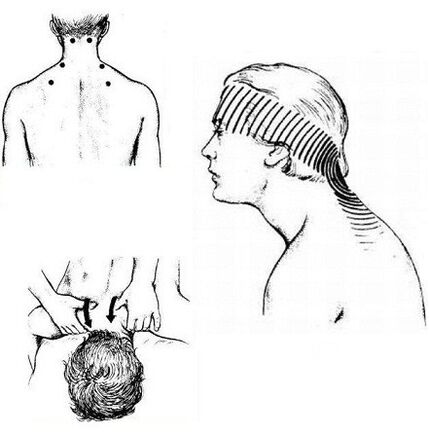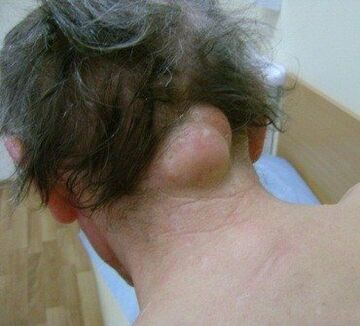
The human neck, like other animals, is an amazing part of the body, quite fragile, but powerful.
The cervical spine, along with all the muscles and ligaments, supports and sets the skull in motion, absorbs shocks when walking, protects the brain from concussions, protects the blood vessels that supply it, and also protects the spinal cord.
It can be argued that almost everyone has had neck pain during their lifetime. Neck pain can affect both men and women of any age.
If the neck hurts, the reasons can be very different. Some of them can resolve on their own within a few days, while others can cause chronic illness and pain.
Why does pain occur?
The most common reason your neck hurts is poor posture. With the back bent, the head stops taking a position just above the body and moves forward. In this position, the muscles and ligaments of the neck experience increased tension. The development of stoop and neck pain is facilitated by prolonged work without changing position, sleeping on a soft bed or high pillow, and prolonged static load.
Other causes of neck pain include injuries from falling headfirst, in a traffic accident, or while exercising. With strong acceleration and subsequent braking, the cervical spine makes a whiplash movement. This can overstretch ligaments and muscles, cause a displacement or compression fracture of the cervical vertebrae and the formation of intervertebral hernias.
Neck pain can appear as a secondary manifestation of other medical conditions. For example, during a heart attack, when a heart attack causes severe pain that radiates along the nerve plexus to the upper limbs, chest and neck. Neck pain with heart attack is only part of a large complex of symptoms - shortness of breath, sweating, nausea, vomiting. If your neck, jaw is sore, and other signs of a heart attack are observed, you should call an ambulance immediately.
Neck pain is also used as a diagnostic sign of meningitis. With this disease, the muscles of the neck become hypertonic, that is, they become stiff. If you try to tilt your head towards your chest, the neck will hurt a lot.
The spine in the neck area hurts with rheumatoid arthritis, osteoporosis, fibromyalgia, spondylosis and arthrosis, hernia or protrusion, with compression of the nerve roots or the spinal cord with infectious edema, abscesses, tumors or benign neoplasms.
special cases
Degenerative diseases
Osteochondrosis, or in other words, dystrophic disorders of the intervertebral discs, causes a person's throat to constantly ache. This is usually a mild aching pain, often accompanied by numbness and pain in the shoulder girdle and head.
The collar area affected by osteochondrosis can cause the development of cerebral artery syndrome. A decrease in the intervertebral spacing in this area leads to pressure damage to the vertebral arteries in the openings of the transverse processes of the cervical vertebrae. The pressure on the vessel leads to a decrease in blood flow to the brain with the onset of dizziness, reduced vision and hearing. On the other hand, mechanical irritation of the artery with pressure from the vertebrae causes a reflex spasm, which manifests itself as a burning, throbbing pain in the head.
treatment
If the neck is constantly aching against the background of osteochondrosis, then therapy begins with the elimination of the pain syndrome. The second mandatory direction of treatment is to stop degenerative processes in the cervical vertebrae.
Pain relief can be achieved through the use of the following groups of drugs:
- nonsteroidal anti-inflammatory drugs - directly block the cascade of mediators that signal pain;
- muscle relaxants - eliminate muscle spasms reflexively resulting from severe pain;
- Sedatives - they soothe and inhibit the nervous system and the transmission of pain impulses, including (valerian, antidepressants, sleeping pills);
- Vasodilators - help get rid of vertebral artery syndrome and associated pain.
To get rid of the cause of neck pain in osteochondrosis, chondroprotective drugs are prescribed, which prevent the destruction of cartilage and vertebrae, as well as multivitamin-mineral complexes.
Pain therapy also includes physiotherapy, physiotherapy, massage, traction, reflex and taping therapy. During an exacerbation, for pain relief, the patient is recommended to wear a special collar that protects the neck from excessive mobility.
muscle pain

Neck pain can occur when the muscles in the neck called myositis become inflamed.
Such pain should be distinguished from neuritis (inflammation of the nerve trunks with a sensory disorder) and pain caused by osteochondrosis.
Myositis occurs suddenly after exposure to predisposing factors - hypothermia, vibration, prolonged overexertion, especially with prolonged repetitive movements of the same kind.
Cervical myositis is characterized by acute pain that occurs when the inflamed muscle contracts. The strong pain intensity leads to difficulties in performing certain types of movement.
Usually pain in the long neck muscles on the anterolateral surface or the sternocleidomastoid muscles, which pull the head back in a bilateral contraction and turn it in a unilateral contraction.
The deep muscles that surround the spine are also often inflamed and move the entire neck and back.
When probing a muscle, its increased tone and dense gnarled areas are found. Violation of microcirculation and local trophism leads to the gradual replacement of myocytes with connective tissue. As a result, the neck muscles weaken, their symmetry is broken on the sides of the spine, torticollis can appear, and it is difficult for the patient to keep the head straight.
treatment
The treatment begins with the relief of the neck. This is followed by a course of physiotherapy procedures - heating with UHF, electrophoresis with drugs, heating with paraffin, wrapping with ozokerite, diathermy, massage, acupuncture. Such procedures restore blood flow to the neck muscles. Of the drugs, injections of B vitamins, anti-inflammatory and analgesic drugs, ointments and rubs are prescribed.
An alternative treatment recommends using cabbage or burdock leaves as pain relieving compresses, making an ointment from crushed willow buds in butter, and rubbing a mixture of turpentine with apple cider vinegar and egg yolk. In addition, the neck is rubbed with lava oil and then wrapped. The main guarantee of the success of any treatment is to soothe the sore neck until its muscles are fully restored. Then you should begin to bring them "into service" through special gymnastics and massage.
Radicular Syndrome
Severe neck pain that spreads to the muscles of the head, shoulder girdle, and upper limbs can occur when the roots of the spinal nerves become pinched with prolapse, protrusion, or a herniated disc.
In this disease, the inner core of the intervertebral disc protrudes towards the spinal canal or its lateral horns. A hernia and its symptoms usually appear on one side. When pressure is applied to the roots of the spinal nerves, a burning, sharp pain occurs in the innervated muscles (cervical spine). The patient feels numbness of the lower jaw, the area around the ears, the back of the head, the shoulder blades, the arms. Dizziness occurs, sharp neck pain when changing position from horizontal to vertical. The gradual protrusion of the nucleus of the disc leads to trauma to the surrounding tissue, its inflammation and edema. This creates the prerequisite for inflammation of the nerve endings with the development of radiculitis, the mobility of the neck and upper limbs gradually becomes limited. A prolonged injury to the spinal nerves leads to paresis or paralysis of the limbs.
therapy
What to do if the neck hurts with a herniaAt home, pain relievers, nonsteroidal anti-inflammatory drugs, hormonal drugs, and muscle relaxants are used to relieve cramps for pain syndrome.
In the hospital, severe neck pain is eliminated with the help of "blockages" - the introduction of anesthetics on the sides of the spine.
The swelling and inflammation are treated with steroids that can be injected directly into the hernia. Muscle soreness is relieved by taking muscle relaxants.
To prevent the further development of hernias, I also use drugs that strengthen cartilage tissue - chondroprotectors.
In many cases, therapeutic exercises and pull traction of the cervical spine with bulging or slight bulging help. The enlargement of the intervertebral space helps to "retract" the intervertebral disc and relieves the nerves.
A real hernia with rupture of the annulus fibrosus and prolapse of the nucleus into the spinal canal requires surgery. There are several ways to get rid of neck pain through surgery:
- anterior cervical discectomy - removal of an extra piece of disc that is pressing on the spinal nerves;
- replacement of the damaged intervertebral disc with an artificial joint that protects the cervical spine from further destruction;
- microendoscopic dissectomy using a posterior approach and removal of small areas of hernia through an endoscope;
- posterior cervical dissectomy through an incision in the neck. The working channel is specially enlarged so that there are no entrapments in the future.
Neoplasms

If there is constant pressing pain in the neck, then one can suspect the appearance of foreign education in this department.
Benign or malignant tumors in the neck area can develop on vertebral bodies, blood vessels, epithelium, connective, nerve, fat or glandular tissue.
Benign tumors (lipoma, fibroma, neuroma, osteoma, hemangioma) usually have the correct shape and are clearly limited, they rarely cause pain. Symptoms are mainly related to the compression of the surrounding tissue by the tumor. Malignant tumors (osteosarcoma, myeloma, lymph node or thyroid cancer) have no limits, they give many metastases to neighboring tissues. Their destructive effect on organs causes a painful feeling, a general deterioration of the condition. The front of the neck can develop cancer of the larynx, throat, mouth, and thyroid. The patient has difficulty swallowing, swelling in the neck and face, a change in voice. If the cervical vertebra is painful with a bone tumor, then this condition is often accompanied by damage to the spinal cord and the nerve roots on the side of the spine with the development of paralysis.
treatment
Treatment of pain in neoplasia is primarily aimed at eliminating the cause - reducing or removing the swelling. For this purpose chemotherapy and radiation therapy, hardening of the tumor-supplying vessels and surgical removal of the pathological formation are used.
Pain relief depends on the severity of the pain:
- weak pain relievers;
- Moderate pain relievers;
- as the pain increases, they switch to weak opiates;
- in severe pain, analgesia is only possible with the help of opiates. To enhance analgesia of neck pain in neoplasms, antipsychotics, anticonvulsants, and corticosteroids are used.
Notice! Neck pain can occur for a number of reasons. In order not to overlook serious diseases, it is first necessary to consult a doctor for advice on the occurrence of pain and the precise determination of the cause.

























